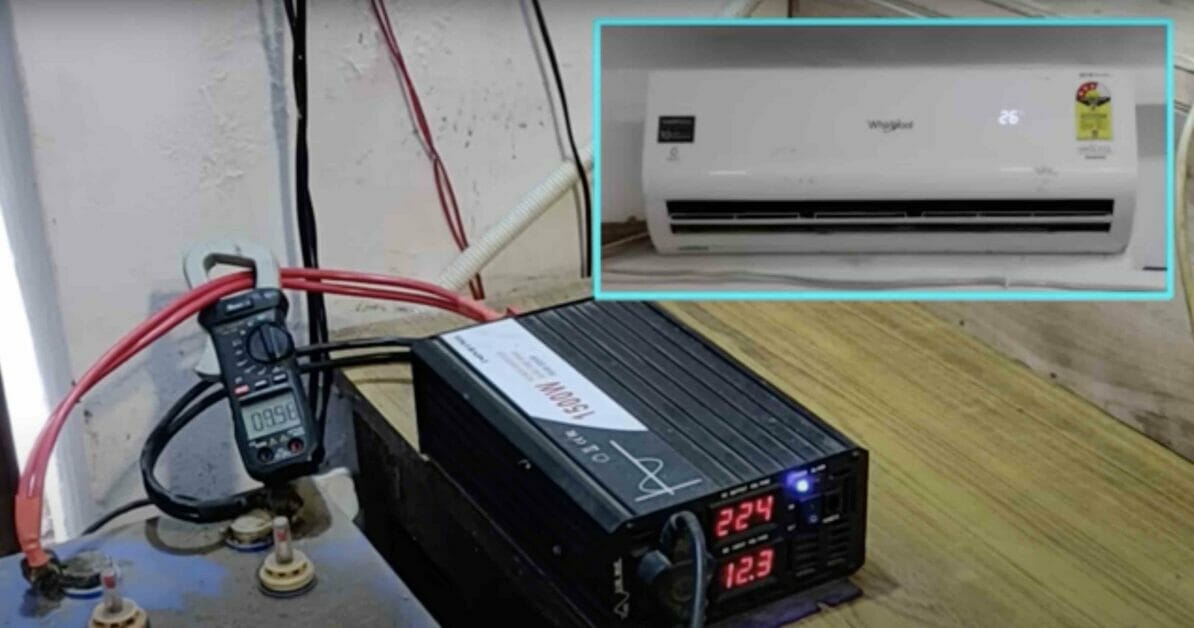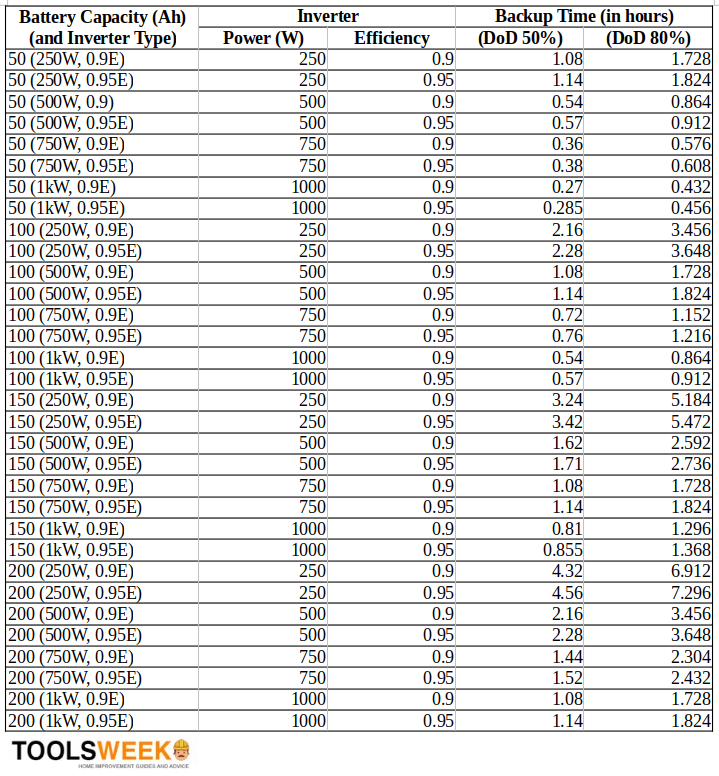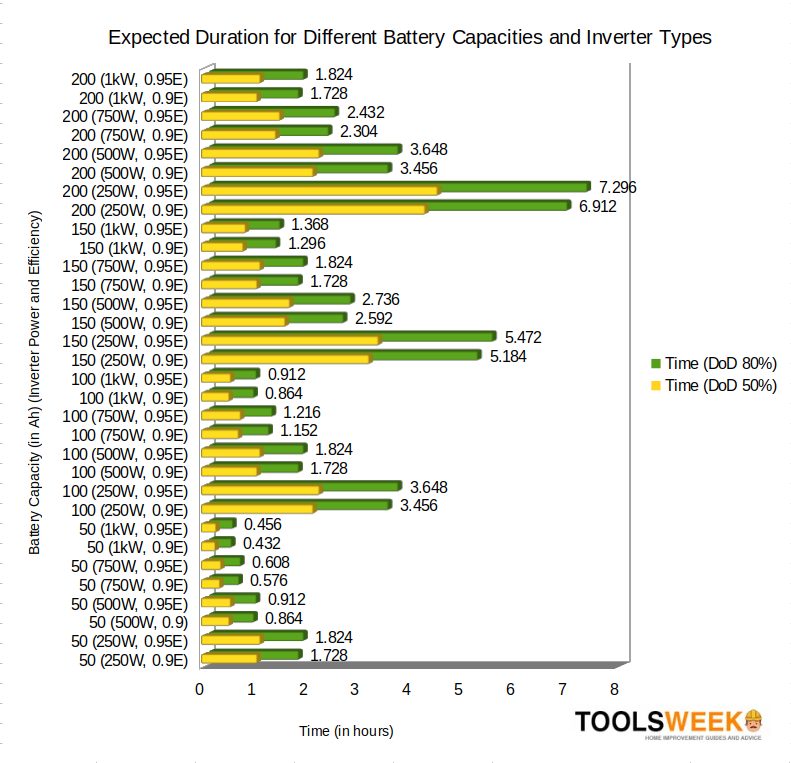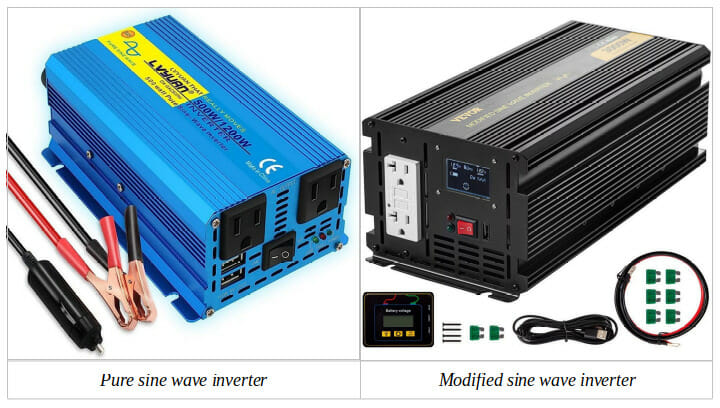How Long Will a 12v Battery Last with an Inverter? (Tips & Calculator)

An inverter is a device for operating AC-powered devices using a 12V battery. But an AC device can only run on a 12V battery for so long.
In general, the time that a 12V deep-cycle battery will last is calculated by multiplying its capacity (Ah value) by 12 and the coefficient of discharge (usually 50% or 80%), allowing for a 5-20% efficiency loss and dividing by the load (or inverter’s power) in watts.
Generally, it will last longer; the higher the battery capacity, the greater the discharge, the more efficient the inverter, and the lower the inverter power or load on the battery.
The four different configurations considered for battery (50Ah, 100Ah, 150Ah, and 200Ah) and inverters (250W, 500W, 750W, and 1kW) show that the backup time ranges from 0.27 to 4.56 hours for 50% discharge and 0.432-7.296 hours for 80% discharge.
I will reveal the formula used to calculate these values and a table and chart you can use to know exactly how much runtime your configuration will give.

Backup Time Calculator
Table of Expected Values

Considering the Duration
Many battery owners who are concerned about how long their battery will last are solar power system owners, those who live off-grid, and those who suffer from frequent power outages.
The battery duration is a critical consideration for such users.
Factors to Consider
Knowing how long a 12V battery can last (backup time or runtime) with an inverter depends primarily on the following:
- Battery voltage and current
- Battery type and depth of discharge (DoD)
- Inverter’s power capacity
- Inverter’s efficiency
- Load attached
Number of Cycles
Batteries don’t remain in their original state when used over time and have a limited lifetime.
Their performance and capacity deteriorate over time—consequently, the older the battery, the less time you can expect it to last.
For example, if you have a regular lead-acid battery with a rated capacity of 100 Ah, its “usable capacity” may only be 50 Ah. This is necessary to maximize its lifespan and is considered a good balance between maximum capacity and cycle life.
However, the 50% depth of discharge (80% for a deep cycle battery) will gradually decrease in line with the number of charge cycles. So you may find that after, for example, 300 charge cycles, the battery is only able to supply 30% of its rated amp-hours.
Now, we will consider what difference including an inverter in the circuit makes.
When Connecting an Inverter to a Battery
Connecting an inverter to a 12V battery converts the 12V DC supply to provide 110/220V AC output.
This allows you to operate AC-powered devices using a 12V battery. Even a low-rated 100W inverter can provide sufficient power to run a laptop. But there’s a limit to how many devices you can power and how long the battery will last. It depends mainly on the inverter’s power and efficiency.
Setting the LVD Parameter
If you want to maximize the battery’s lifespan, set a “Low Voltage Disconnect” (LVD) parameter on the inverter to 12.2V (or a minimum of 12.15V).
This will ensure the battery is not discharged below the 50% limit to remain healthy.
Also, ensure they are fully recharged after every discharge. The battery will remain in good condition if the charge is frequently kept at 100%.
Formula to Calculate Backup Time
Here’s the formula to help you calculate the backup time you can expect:
Backup time = Ah x V x E x C / W
where Ah is the battery’s capacity rating, V (voltage) = 12V, E is the inverter efficiency (usually taken to be 90-95%), C is the coefficient of discharge (usually taken to be 0.8), and W is the device load in watts.
For example, suppose you use a 250W inverter that draws 20.8 amps of current (250 / 12 = 20.83). Even without a load, a typical 60Ah small car or caravan battery will hardly last three hours. It will discharge quicker if you attach a load.
However, one way around the inverter’s load is to buy one that can use mains electricity, as the only load will be the one attached to it. It will make it last longer, but it is only possible when you can access an AC power supply.
Another Example
Suppose you have a 200 Ah regular lead-acid battery that can be safely discharged to 50% and a 1kW inverter with 95% efficiency.
We will make two calculations: One for how long the battery should be used (50% DoD) and one for how long it can last (80% DoD), i.e., disregarding the safe discharge limit or if using a deep cycle battery.
- 50% DoD: backup time = 200 x 12 x 0.95 x 0.5 / 1000 = 1.14 h = 1 hour and 8.4 minutes
- 80% DoD: backup time = 200 x 12 x 0.95 x 0.8 / 1000 = 1.824 = 1 hour and 49.44 minutes
So, you can safely use this setup for around 1 hour and 8 minutes, but if you want, you can continue using the battery to make it last up to 1 hour and 49 minutes.
Table and Graph of Expected Values
To save you from having to do calculations, I’ve given the expected duration or backup time in the table below for 4 different configurations of 12V batteries (50Ah, 100Ah, 150Ah, and 200Ah) and inverters (250W, 500W, 750W, and 1kW, each at 0.9 and 0.95 efficiency).

In the graph below, the different battery and inverter configurations are on the vertical axis, and the expected time is on the horizontal axis. The yellow bars show the time if you discharge up to 50%, and the green bars show if you discharge up to 80% (with the actual value in hours displayed on the right).

For example, a 200 Ah battery operating a 95% efficient 250W inverter will last the longest at 7.296 hours (7 hours and 17.76 minutes).
There is sufficient data above to estimate the backup time for other configurations. Otherwise, you can do the calculation instead. Generally, you will get a longer backup time:
- The higher the battery capacity, the greater the discharge allowed and the more efficient the inverter.
- The lower the inverter power or load on the battery.
More about Inverters and Batteries
There are different types of inverters you can buy.
Knowing about these types could help you choose one that suits your need better and can last longer.
Pure and Modified Sine Wave Inverters

Inverters can be divided into those that produce pure sine wave outputs and modified sine waves.
Pure sine wave inverters are ideal for operating delicate or high-quality electronics. In contrast, modified sine wave inverters produce a square sine wave output and are acceptable and cheaper for general use.
Sine wave inverters are also more reliable, efficient (above 90%, compared to 75%), and quieter but more expensive. Their efficiency is typically between 92% and 97%, although some highly efficient models can reach up to 99% efficiency. Modified sine wave inverters are less reliable, inefficient, and noisier.
So, if you have a large load or an important appliance with high-quality electronics inside, use a pure sine wave inverter. The greater efficiency will help to make the battery last longer to power your device.
Matching the Inverter to the Load
For an ideal experience, you should try to match the inverter to the load.
The load cannot exceed the inverter’s maximum power. So, if, for instance, you have a load of 1600-1900W, you should get a 2kW inverter.
Inverters up to 20kW or more are available. So, you can easily power a small home, camp, or RV. But you must also have enough battery power for adequate battery runtime.
Type of Lead-Acid Battery
The type of lead-acid battery makes a big difference because some are designed to power loads over long periods, while others are not.
Ordinary lead-acid car batteries are only suitable for starting, lighting, and ignition, called SLI batteries. They are designed to provide a high current for cranking a cold engine but are unsuitable for powering continuous loads.
The deep cycle battery is the ideal lead-acid battery type for continuous load and sustaining long periods of use. It is popular with RVs, too. It can be discharged up to 80% of its capacity if needed; otherwise, it is recommended not to discharge it more than 50% so that it can last longer.
Lithium-Ion Batteries
A lithium-ion battery is a good choice if you want a battery to last long.
It will come at a high price, around twice as much as a regular lead-acid battery, but will last about 4-5 times longer.
Another advantage, which contributes to making it last long, is that you can discharge it to 95% of its capacity. Considering this factor, a 50 Ah LiFePo4 battery is roughly equivalent to a 100 Ah regular lead-acid battery.
Number of Batteries
We assumed above that you connect an inverter to only one 12V battery.
You can easily double the battery runtime by adding more batteries in series to create a battery bank.
For example, if you connect a 1kW inverter with 95% efficiency to a single 200 Ah, 12V battery, you can expect the runtime to be 1.14 hours if discharging to 50% or 1.824 if discharging to 80%. You will double the runtime by adding a second 12V battery to double the voltage to 24V.
References
Modified sine wave inverter. https://www.walmart.com/ip/VEVOR-Power-Inverter-3600W-Modified-Sine-Wave-DC-12V-AC-120V-Car-Converter-LCD-Display-Remote-Controller-LED-Indicators-Outlets-GFCI-RV-Truck-Boat-Tr/913963654
Pure sine wave inverter. https://www.amazon.com/LVYUAN-Power-Inverter-Ports-Outlets/dp/B09B58V3Y8
Sammy Faircloth. The Caravan Handbook, Sammy Faircloth 2021
Video Reference
Mr Electron
